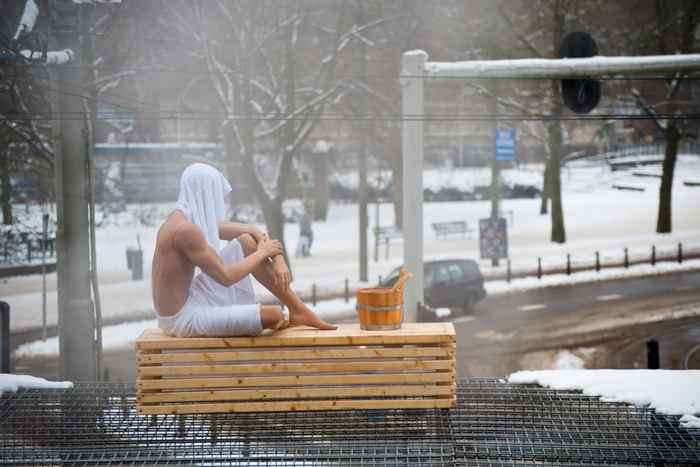About the Saunaman
The Saunaman forms a good example of the subjects that we discuss during our classes.
Guerrilla art
In the early morning of January 14, 2010, commuters at the busy Weteringcircuit intersection in Amsterdam were startled by an unexpected sight. A semi-nude man, with just a towel wrapped around his head and another around his hips, was taking a bath in the steam rising from the vent of a construction site. The wooden bench and bucket he had brought along helped to complete the impression of an intimate sauna cabin. Except, of course, for the fact that it was located at a public intersection in the midst of winter.
Concerned for the man’s health, several passers-by called the police; others suspected an elaborate and very public suicide attempt. When the police arrived, the man turned out to be a lifelike dummy.
The whole thing, it appeared, was an improvised, anonymous art intervention or installation situated in public space. This form of art is called "guerrilla" art, and it is usually carried out by activist and subcultural groups. The goal is to provoke, to amuse, to raise awareness, to make people think.

Clash of opposites
With the addition of only a few simple props – a dummy, a wooden bucket – a mundane construction site in Amsterdam became a sauna. An intimate scene of leisure and relaxation disrupted daily life at a busy traffic intersection. The effect of Saunaman, as the work was soon called, revolved on a deliberate clash of opposites: outside/inside, public/private, work/leisure, dressed/naked. When you notice the clouds of steam, what is it that you perceive? A construction site? A sauna? Just a matter of perspective. Let’s take the day off!
But who was behind this piece of successful guerrilla art? A collective protesting against urban planning policies in Amsterdam? Hippies celebrating public nudity? A group objecting to labour discipline? What were the intentions of the makers? What was the larger point the Saunaman was designed to make?
The man behind the Saunaman
After a while, the anonymous guerrilla artist turned out to be Frank de Ruwe. De Ruwe is the creative director of the advertising agency Natwerk. Which instantly begs the question: was the Saunaman really a piece of spontaneous guerrilla art – or actually a calculated public relations stunt? Could it be that the subcultural and activist practice had been hijacked by a PR firm?
The particular construction site where the Saunaman appeared belonged to new North-South line of the Amsterdam underground. Construction had started in 2003. After a long series of delays, the line was completed in 2018. By 2010, the project was in deep trouble because of excessive budget overdrafts and accidents. Because of the tortuous construction in Amsterdam’s soft, marshy soil, an entire row of historic mansions had started to collapse. The whole enterprise had become a PR disaster. Maybe a diversion was called for?